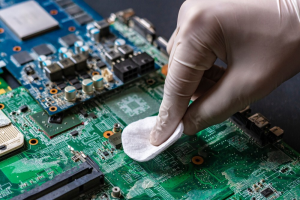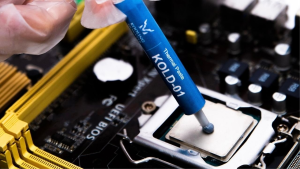How to Clean Thermal Paste Off CPU
To clean thermal paste off a surface, follow these steps. First, ensure the device is powered off and disconnected. Gently remove the heatsink or cooler. Using isopropyl alcohol (90% or higher concentration) and a lint-free cloth or coffee filter, dampen the cloth slightly with the alcohol. Gently wipe away the thermal paste, avoiding excess pressure. Repeat until the surface is clean. If stubborn residue remains, use a plastic or wooden tool to gently scrape it off. Once clean, let the surface dry completely before applying new thermal paste and reattaching the cooler. Exercise caution to prevent damage and static discharge during the process.
Safety Precautions
Before you dive into the cleaning process, it’s essential to take some safety precautions to protect both yourself and your computer. Make sure to turn off and unplug your computer from the power source. Allow it to cool down for a few minutes to avoid any burns from hot components.
Gather Your Supplies
For this task, you’ll need a few essential supplies, including:
- Isopropyl alcohol (highest concentration available)
- Cotton swabs or lint-free cloths
- Thermal paste remover (optional but recommended)
- New thermal paste
- Plastic scraper or credit card (for scraping off the old paste)
Shutting Down and Disassembling
Properly shut down your computer and disconnect all cables. Open the computer case and carefully remove the CPU cooler, following the manufacturer’s instructions. Discover about Cars Hyundai Electric Car: Way to a Green Automotive Future
Cleaning the CPU Surface
Dampen a lint-free cloth or cotton swab with isopropyl alcohol and gently clean the surface of the CPU. Remove any dirt, debris, or remnants of the old thermal paste. Make sure not to apply excessive pressure, which could damage delicate components.
Removing the Old Thermal Paste
Using a plastic scraper or credit card, carefully scrape off the old thermal paste from both the CPU and the heat sink. If the paste is stubborn, you can use a thermal paste remover to dissolve it effectively.
Applying New Thermal Paste
Apply a small, pea-sized amount of new thermal paste to the center of the CPU. Use a plastic bag or a gloved finger to spread the paste evenly over the CPU’s surface. This ensures optimal heat conductivity.
Reassembling and Testing
Carefully reattach the CPU cooler according to the manufacturer’s instructions. Make sure it’s securely fastened to provide proper contact with the CPU. Once everything is reassembled, power on your computer and monitor the temperatures to ensure they have improved.
Tips for Better Thermal Performance
- Regular Maintenance: Clean and reapply thermal paste every couple of years for consistent cooling performance.
- Quality Paste: Invest in a high-quality thermal paste for better results.
- Even Application: Apply the paste evenly to ensure complete coverage and uniform heat transfer.

Is it necessary to clean off the old thermal paste
Yes, cleaning off the old thermal paste is crucial. Over time, thermal paste can dry up and lose its effectiveness, leading to decreased heat transfer efficiency. By removing the old paste and applying new thermal paste, you ensure optimal thermal conductivity between the CPU and its cooler.
While there are various thermal paste options available, it’s recommended to use a high-quality thermal paste from reputable manufacturers. Different pastes have varying levels of thermal conductivity, which can impact cooling performance. Investing in a trusted brand will often yield better results.Applying too much thermal paste can actually hinder heat transfer rather than improve it. The excess paste can create an insulating layer and air pockets, leading to higher temperatures. It’s essential to apply a small, appropriate amount of thermal paste to achieve optimal results.
Additional Tips for Applying Thermal Paste
While you now have a solid understanding of the basic process of cleaning and reapplying thermal paste, there are a few additional tips that can help you achieve even better results:
Proper Application Technique
When applying the new thermal paste, it’s crucial to use the right technique. The “pea method” or the “line method” are popular choices. With the pea method, you place a small pea-sized dot in the center of the CPU and let the pressure from the cooler spread the paste. The line method involves placing a thin line of paste horizontally across the center of the CPU.
Avoid Excessive Pressure
While reattaching the CPU cooler, ensure you don’t apply excessive pressure. Too much pressure can create air bubbles in the thermal paste, reducing its effectiveness. Follow the manufacturer’s guidelines for the appropriate amount of pressure required to secure the cooler.
Monitor Temperature Changes
After you’ve applied the new thermal paste and reassembled your computer, closely monitor temperature changes. Use software tools to keep track of the CPU temperature during idle and load conditions. This will help you ensure that the new thermal paste is providing the desired cooling effect.
Regular Dusting
Dust accumulation on the CPU cooler and heat sink can hinder the effectiveness of thermal paste. Regularly clean your computer’s interior to prevent dust buildup and maintain optimal cooling performance.
Upgrading Your Cooler
If you consistently experience high temperatures even after reapplying thermal paste, consider upgrading your CPU cooler. A high-quality cooler with improved heat dissipation capabilities can make a significant difference in temperature managemenAs you delve into the realm of thermal paste and CPU maintenance, you might come across a few common questions and concerns. Let’s address these queries to provide you with a comprehensive understanding of the topic. Also read about Chat GPT For Android
Can I use a credit card to remove the old paste
While using a credit card as a scraper is a common approach, it’s important to exercise caution. Credit cards can be sharp and may inadvertently scratch the CPU surface or heat sink. It’s safer to use a plastic scraper specifically designed for electronic components.In most cases, cleaning and reapplying thermal paste won’t void your warranty, especially if you follow the manufacturer’s guidelines for disassembly. However, it’s always a good idea to check your warranty terms or contact customer support if you’re unsure.
Alcohol wipes can work, but make sure they are lint-free and contain isopropyl alcohol with a high concentration (above 90%). This ensures effective cleaning without leaving residue.
Applying new thermal paste
If you’ve followed all the steps correctly and temperatures haven’t improved, there could be other factors at play, such as inadequate cooling solutions or improper installation of the CPU cooler. In such cases, consider seeking expert assistance.

While it’s possible to remove the CPU from the socket for thorough cleaning, it’s generally not necessary. You can clean the CPU in place as long as you’re careful and avoid damaging the pins or contacts. Yes, you can use thermal paste on a laptop CPU to improve its cooling efficiency. However, laptop disassembly can be more complex, and it’s recommended to follow a guide specific to your laptop model or seek professional help. The lifespan of thermal paste varies depending on factors like quality, usage, and environmental conditions. On average, it’s a good idea to replace thermal paste every two to three years for optimal performance.
Conclusion
Cleaning thermal paste off your CPU might seem intimidating, but with the right steps and precautions, it’s a manageable task that can significantly improve your computer’s performance. By following these guidelines and applying new thermal paste, you’ll keep your CPU running at optimal temperatures and extend its lifespan.
FAQs
How often should I replace the thermal paste on my CPU?
It’s recommended to replace the thermal paste every two to three years or whenever you notice temperature issues.
Can I use rubbing alcohol instead of isopropyl alcohol?
Rubbing alcohol can work, but isopropyl alcohol with the highest concentration is more effective due to its purity.
What if I accidentally apply too much thermal paste?
Excessive thermal paste can lead to poor heat transfer. It’s best to wipe off the excess and reapply a proper amount.
Can I reuse the old thermal paste I removed?
Reusing old thermal paste is not recommended, as its effectiveness diminishes over time.
Do different CPUs require different types of thermal paste?
While some thermal pastes are optimized for specific CPUs, a high-quality universal thermal paste will work well for most processors.
